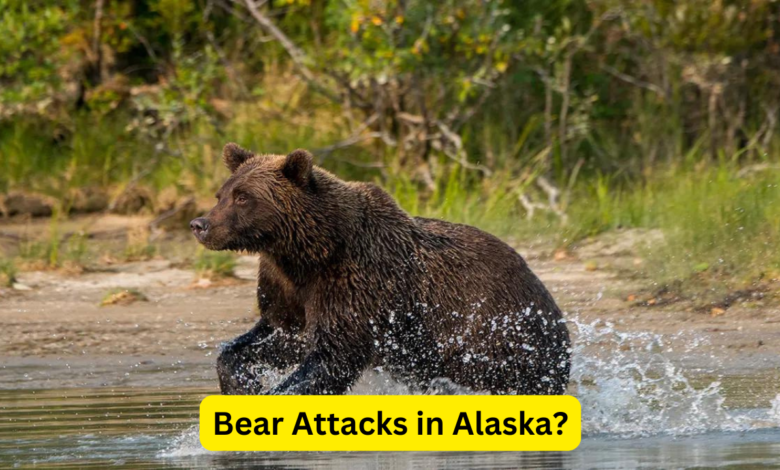Bear Attacks in Alaska?

Bear Attacks in Alaska, The wild, rugged landscapes of Alaska are a haven for adventurers, offering breathtaking views and unparalleled experiences. Yet, with this natural beauty comes inherent danger, particularly in the form of bear encounters. The frequency of bear attacks in Alaska has been increasing, making it essential for anyone venturing into these areas to understand the risks, recognize bear behavior, and adopt the necessary precautions to stay safe.
Understanding the Bear Species in Alaska
Alaska is home to three primary bear species: grizzly bears, black bears, and polar bears. Each species has distinct characteristics, and understanding these can be the first step in avoiding dangerous encounters.
Grizzly Bears: The Apex Predator
Grizzly bears, also known as brown bears, are the most formidable predators in Alaska. Known for their sheer size and strength, grizzlies can weigh anywhere from 400 to 1,200 pounds and stand over 7 feet tall on their hind legs. Their powerful jaws and claws make them incredibly dangerous, particularly when they feel threatened or are protecting their young. Grizzlies are typically solitary animals but can become aggressive if surprised or provoked.
Black Bears: Smaller, Yet Still Dangerous
Black bears are smaller than grizzlies, with adults weighing between 150 to 600 pounds. Despite their size, black bears can be just as dangerous, especially if they feel cornered or if their cubs are threatened. These bears are more widespread across Alaska and are often less aggressive, but their unpredictability makes them a significant risk to humans.
Polar Bears: The Arctic Giants
Polar bears, found primarily in the northernmost regions of Alaska, are the largest of the three species. They are highly specialized for survival in the Arctic, primarily hunting seals. Polar bears are the most carnivorous of all bear species and are known to be particularly dangerous due to their size, strength, and lack of fear toward humans.
The Rising Threat of Bear Attacks in Alaska
In recent years, bear attacks in Alaska have become more frequent, especially among hunters. As human activity increasingly encroaches on bear habitats, the likelihood of encounters grows. Hunters are at particular risk, as the scent of game, especially blood, can attract bears, leading to potentially deadly confrontations. However, the risk is not limited to hunters—hikers, campers, and local residents in bear-populated areas are also vulnerable.
The rise in bear attacks is often linked to bears losing their natural fear of humans, a behavior that can be exacerbated by improper food storage and habituation to human presence. As more people venture into bear territories without proper precautions, the frequency of these dangerous encounters is likely to increase.
Essential Precautions for Avoiding Bear Encounters
Preparation and vigilance are key to preventing bear encounters. Here are some critical steps to take before and during your time in bear country:
Carry and Know How to Use Bear Spray
Bear spray is one of the most effective tools for deterring an attacking bear. It is a highly concentrated form of pepper spray that can temporarily incapacitate a bear, giving you time to escape. Always have bear spray readily accessible, and practice using it before heading into the wilderness. Familiarize yourself with removing the safety clip and aiming correctly, so you’re prepared in a high-pressure situation.
Make Noise to Announce Your Presence
Bears typically avoid humans, so making noise as you move through bear country can prevent surprise encounters. Talk loudly, clap, or carry a noise-making device, especially when moving through dense vegetation or near water sources where bears might be foraging.
Proper Food Storage: A Key to Safety
Bears have an extraordinary sense of smell and can detect food from miles away. Improperly stored food is a major attractant, so always use bear-resistant containers or hang food at least 10 feet off the ground and 4 feet away from any tree trunk. Never store food inside your tent. This precaution is crucial in preventing bears from associating humans with food, which can lead to dangerous behavior.
Travel in Groups for Added Safety
Bears are less likely to approach groups of people. If possible, travel with others when in bear country. Staying close together and avoiding splitting up can reduce the chances of an encounter.
Recognize Signs of Bear Activity
Learning to identify bear tracks, scat, and other signs of bear presence can help you avoid areas where bears are active. If you come across fresh bear signs, leave the area immediately. Bears are most active during dawn and dusk, so exercise extra caution during these times.
What to Do During a Bear Encounter
Even with all the precautions, bear encounters can still happen. Knowing how to react in such a situation is crucial for your survival.
Stay Calm and Avoid Sudden Movements
It’s natural to feel panic, but staying calm can prevent the situation from escalating. Avoid making any sudden movements that could trigger the bear’s chase instinct.
Identify Yourself to the Bear
Speak to the bear in a calm, firm voice. This helps the bear understand that you are human and not prey. Slowly raise your arms to make yourself appear larger, but avoid direct eye contact, as this can be perceived as a threat.
Do Not Run
Running from a bear is a mistake—bears can run up to 35 miles per hour, much faster than any human. Instead, back away slowly while keeping the bear in view, but do not make direct eye contact.
Use Bear Spray if Necessary
If the bear continues to approach, be ready to use your bear spray. Aim slightly downward to ensure the spray forms a cloud that the bear will walk into. Bear spray is most effective at a distance of 20 to 30 feet, so use it when the bear is close but not within arm’s reach.
Know When to Play Dead or Fight Back
If a grizzly bear attacks, playing dead may save your life. Lie flat on your stomach, protect your neck with your hands, and spread your legs to make it harder for the bear to turn you over. Remain still until the bear leaves the area.
If a black bear attacks, do not play dead. Instead, fight back with all available resources. Use any objects you have as weapons, and aim for the bear’s face and muzzle.
After a Bear Attack: Immediate Actions
If you survive a bear attack, seek medical attention as soon as possible, even if your injuries seem minor. Bear bites and scratches can lead to severe infections, and prompt treatment is essential. Report the attack to local wildlife authorities, as this information can help prevent future incidents and contribute to bear conservation efforts.
In cases of fatal bear attacks, it’s important to recognize the role of bears in Alaska’s ecosystem. While bear attacks are tragic, these animals are a vital part of the natural environment, and efforts must be made to balance human activities with wildlife conservation.
Conclusion
Bear attacks in Alaska are a sobering reminder of the risks inherent in exploring wild, untamed areas. By understanding bear behavior, taking necessary precautions, and knowing how to react in an encounter, we can significantly reduce the chances of a fatal bear attack. Respect for the wilderness and its inhabitants is crucial in ensuring that our presence in bear country does not lead to unnecessary conflicts.




